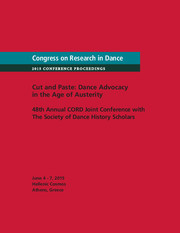No CrossRef data available.
Article contents
Dance Activism and Media Market: Jampi Gugat
Published online by Cambridge University Press: 02 August 2016
Abstract
Jampi Gugat is a case study of dance activism particularly through flash mob. The movement configuration and music accompaniment clearly reflect the idea and concept of local wisdom as an alternative trend and solution in the global era. One of the key points for the success of Jampi Gugat is related to the campaign strategy regarding the media market in Indonesia, the world's third largest democracy and a developing country that tends to prioritize political-economy development rather than art and culture, including dance. Hence, the involvement of stakeholders: government, event organizers, artists, and communities, as well as their interaction, to formulate and deliver some value to society are deemed essential to create a sustainable cultural movement.
- Type
- Research Article
- Information
- Copyright
- Copyright © Sekar Sari 2016


